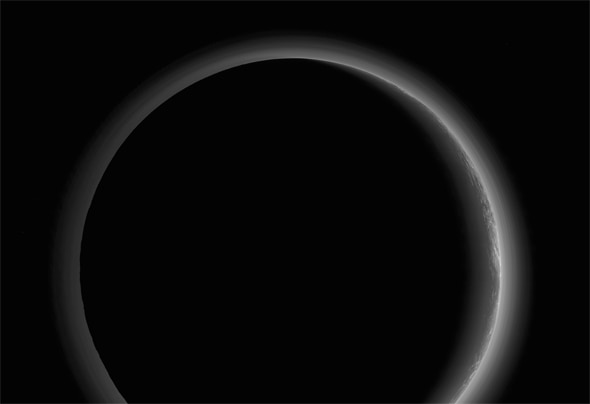Create a free profile to get unlimited access to exclusive videos, sweepstakes, and more!
Breathe Deep Pluto's Gathering Gloom

At this point, the New Horizons probe is nearly 400 million kilometers past Pluto, more than twice the distance from the Earth to the Sun, now almost a year after it shot past the diminutive ice world.
But on July 15, 2015, just after it passed Pluto, it turned around and took a series of high-resolution images looking back toward Pluto. Those images have been processed and put together into a stunning mosaic, shown above. Well, a small version of it; click it to get the magnificent 5,000 x 7,300 pixel version (hint: If you use a image viewer with some control, set the contrast up high to see more features).
This shot is simply stunning. The geometry alone is amazing to me. Pluto is roughly five billion km from the Sun, and from that distance the Earth and Sun are so close together they might as well be sitting in the same spot. So when the probe swept past Pluto, it was heading very nearly straight away from the Sun, and when it looked back to take the images comprising this shot, the Sun was on the other side of Pluto… when means New Horizons was seeing the dark, unlit side of Pluto.
Well, nearly. Pluto is seen as a thin crescent, a bit of its surface visible. But its atmosphere! What little gas Pluto has over its surface is incredibly thin; the Earth’s air at sea level is 100,000 times thicker. But it’s there, and has a series of haze layers in it, probably organic (carbon-based) molecules created as ultraviolet light from the Sun breaks down methane and allows the constituent atoms to recombine. Those layers are easily seen in this image.
But I’m amazed at the surface detail. This image is not the same as one released in October 2015; the angle looking back on Pluto is different, so different features are visible. Two things in particular are worth noting.
Near the bottom right of the image, just inside the limb of Pluto, there’s a very odd whitish feature. It looks fuzzy, doesn’t it? That might be —might be— a cloud. Sunlight can warm the surface of Pluto enough that a low-lying methane cloud could exist. It would be hard to see looking straight down on it, but because we see it here at such a low angle (and with the Sun shining nearly through it) it appears more obvious. It may just be a surface feature though. It’s very hard to tell. We may never know: New Horizons was a flyby mission; there was no way to carry enough fuel to go into orbit. Because of that it flew past and that’s that.
Higher up around Pluto’s limb are a series of mountainous features. These are darker, possibly made of water ice covered with more of those complex organic molecules. You can see them poking right over the horizon, and there’s one about a third of the way down from the top whose base is clearly over the horizon, with the peak sticking up high enough to see. Incredible.
From a distance, Pluto looks pretty round, but it’s obvious from this view that it’s actually quite bumpy. Mountains of water ice as high as three kilometers climb out of it. Pluto is much smaller than Earth (2,370 km versus nearly 13,000), so to scale mountains that big on Earth would be over 16 km high, almost twice as high as Mt. Everest. Earth is a lot smoother than Pluto.
As I was looking at this image, I found myself applying scientific diagnostics to it. My eye went to each little feature, ever change in contrast and size, my brain ticking over trying to categorize, analyze, understand.
But then I zoomed out, and saw the whole image filling my screen, and unbidden a thought leapt to me:
In this picture we’re seeing all the sunrises and all the sunsets all at the same time all over Pluto.
This little world, so distant and cold, may be of enduring interest to scientists for centuries to come. But it also is poetry. Art.
Let it incite and excite all the parts of our brains, as all natural wonders should.


























